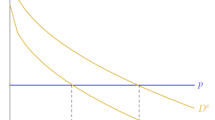Abstract
Recent statutory developments in U.S. local government law have placed more comprehensive administrative procedures and constraints upon those individuals wishing to alter their form of local government. What effect, if any, have these “reforms” had upon the performance of local government; has government become more efficient in providing goods as one body of literature seems to suggest, or has local government become more monopolistic as a result of reduced competition as other strands of thought suggest? By examining the budgetary behavior of local governments under alternative institutional structures, this paper examines these alternative perspectives. The empirical evidence suggests that entry barriers significantly alter the performance of local governments and allow existing units of government to cartelize the market.
Similar content being viewed by others
References
Barlow, R. (1969). Comment on Alternative Federal Policies for Stimulating State and Local Expenditures.National Tax Journal, Vol. 22, 282–85.
Bergstrom, T. E. and Goodman, R. P. (1973). Private Demands for Public Goods.American Economic Review, Vol. 63, 280–296.
Bish, R. L. and Ostrom, V. (1973).Understanding Urban Government: Metropolitan Reform Reconsidered. Washington: American Enterprise Institute for Public Policy Research.
—, and Warren, R. (1972). Scale of Monopoly Problems and Urban Government.Urban Affairs Quarterly, Vol. 8, 97–122.
Bollens, J. C. and Schmandt (1965).The Metropolis: Its People, Politics, and Economic Life. New York: Harper and Row.
Borcherding, T. and Deacon, R. T. (1972). The Demand for the Services of Non-Federal Governments.American Economic Review, Vol. 62, 891–901.
Breton, A. (1974).Economic Theory of Representative Government. Chicago: Aldine-Atherton.
Braford, D. and Oates, W. (1974). Suburban Exploitation of the Central Cities and Governmental Structure.Redistribution Through Public Choice. New York: Columbia University Press.
Buchanan, J. (1974). Who Should Distribute What in a Federal System.Redistribution Through Public Choice. New York: Columbia University Press.
—, and Goetz, C. (1972). Efficiency Limits of Fiscal Mobility: An Assessment of the Tiebout Model.Journal of Public Finance, Vol. I, 24–43.
Campbell, A. and Sacks, S. (1967).Metropolitan America: Fiscal Patterns and Governmental Systems. London: The Free Press.
Johnston, J. (1972).Econometric Methods. New York: McGrawHill.
Martin, D. T. (1978).Local Government Controls: Effects on Efficiency and Monopoly Power. Unpublished manuscript.
—, and Wagner, R. (1978). The Institutional Framework for Municipal Incorporation: An Economic Analysis of Local Formation Commissions in California.Journal of Law and Economics, Vol. 21, 409–425.
McKean, R. (1973). An Outsider Looks at Urban Economics.Urban Studies, Vol. 10, No. 1: 19–37.
Niskanen, W. A. (1971).Bureaucracy and Representative Government. Chicago: Aldine-Atherton; and (1975) Bureaucracy and the Interest of Bureaucracy.Journal of Law and Economics, Vol. 18.
Ostrom, E. (1972). Metropolitan Reform: Propositions Derived from Two Traditions.Social Science Quarterly, Vol. 53, 474–93.
—, and Ostrom, V. (1971). Public Choice: A Different Approach to the Study of Public Administration.Public Administration Review, Vol. 31, 203–16.
Ostrom, V., Tiebout, C. and Warren, R. (1961). The Organization of Government in Metropolitan Areas.American Political Science Review, Vol. 4, 831–42.
Tiebout, C. (1966). A Pure Theory of Public Expenditures.Journal of Political Economy, Vol. 44, 416–24.
Scott, S., Keller, L. and Bollens, J. (1961).Local Government Boundaries and Areas. Berkeley: University of California Press.
Stigler, G. (1971). The Theory of Economic Regulation.Bell Journal of Economics and Management Science, Vol. 2, 3–21.
Tullock, G. (1965).The Politics of Bureaucracy. Washington, D. C.: Public Affairs Press.
Wilensky, G. (1970). Determinants of Local Government Expenditures.Financing the Metropolis: Public Policy in Urban Economics, 190–217.
Wingo, L. (1972).Reform of Metropolitan Governments. Baltimore: Johns Hopkins.
Author information
Authors and Affiliations
Additional information
The author is indebted to Richard E. Wagner, Richard B. McKenzie, and to Dale G. Bails for programming assistance with the empirical work.
Rights and permissions
About this article
Cite this article
Martin, D.T. Entry restrictions and expenditure effects in the local government market. Ann Reg Sci 14, 12–22 (1980). https://doi.org/10.1007/BF01284200
Issue Date:
DOI: https://doi.org/10.1007/BF01284200




